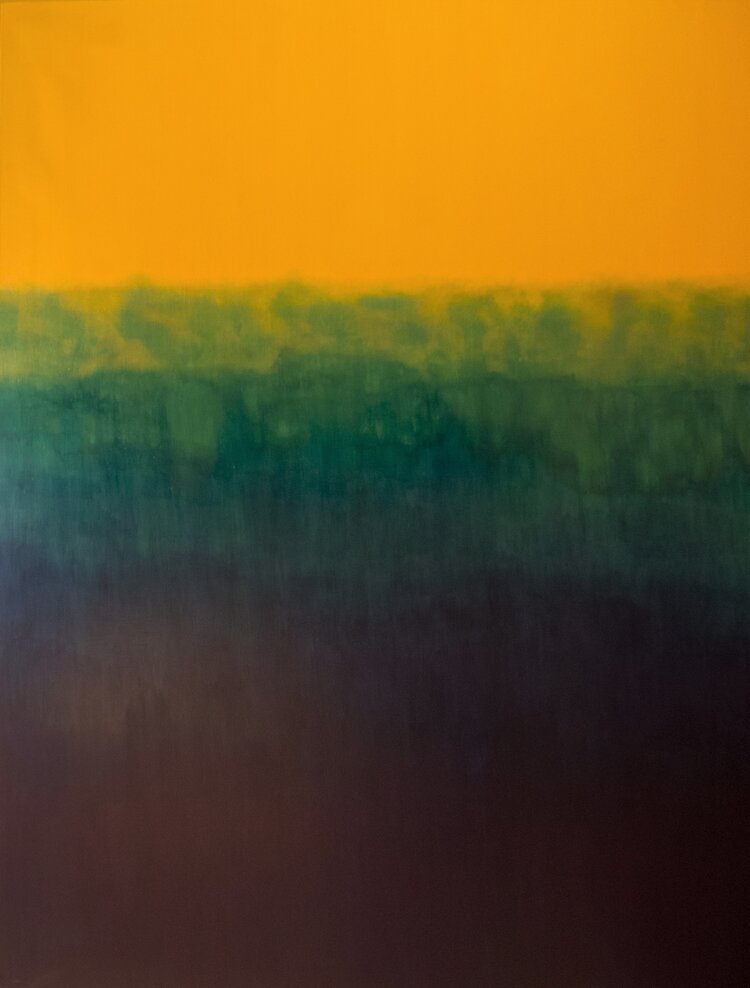Welcome to Your Guide on Decorating with Fine Art
Choosing the right word for your space
When selecting original art for your home or office, the size of the artwork plays a crucial role in enhancing the overall aesthetics of a space. Understanding the impact of art size can help you create a harmonious environment that resonates with your personal style while also reflecting the intended atmosphere of the room.
From The Wind And Other Acrylic Painting/ From the Wind - March Wind 2/ Acrylic on Canvas/ Size: 69" X 60"
First, consider the dimensions of the wall where the artwork will be displayed. A large piece can serve as a focal point, drawing the eye and creating a sense of drama. Conversely, smaller artworks may work better in groups, allowing for a more intimate display that encourages viewers to engage with each piece individually. To achieve balance, ensure that the size of the artwork complements the scale of the room and its furnishings.
Envisioned Landscapes/ This Land is Safe and Secure/ Oil on Canvas/ Size: 66" X 84"
In spacious areas, oversized art can fill empty wall space and add character, while in smaller rooms, a single large piece might overwhelm the space. Instead, opt for a series of smaller pieces or a gallery wall that showcases various works at different heights and arrangements. This not only makes the room feel inviting but also adds depth and interest.
Additionally, the height at which you hang the artwork can significantly affect its impact. Art should generally be hung at eye level, which is typically around 57 to 60 inches from the floor. However, in rooms with high ceilings, you might need to adjust this height to create a visual balance. Consider how the size of the art interacts with the surrounding elements, such as furniture, lighting, and architectural features.
Finally, think about the art's theme and how its size complements the subject matter. Larger pieces often convey bold statements or evoke strong emotions, while smaller works may invite quieter contemplation. By thoughtfully considering the size of the art in relation to your space, you can create an environment that not only looks aesthetically pleasing but also resonates on a deeper level, enriching your experience as an art buyer and collector.

Works on Paper/ Duet 1/ Screen Prints/ Size: 17" X 14"

Works on Paper/ Duet 2/ Screen Prints/ Size: 17" X 14"
When selecting original art for your home or office, understanding the dimensions of your space is crucial. The right size artwork can enhance the atmosphere, create focal points, and complement your existing decor. Here are some key considerations to help you measure your space effectively and find the perfect dimensions for your art pieces.
Analyze Your Walls: Start by assessing the walls where you plan to hang your artwork. Measure the height and width of each wall and take note of any architectural features such as windows, doors, or built-ins that may affect your layout. This will give you a clear idea of the available space and help you visualize how different sizes of art will fit.
Consider the Height: A common mistake is hanging artwork too high. Ideally, the center of the artwork should be at eye level, which is typically around 57 to 60 inches from the floor. If you're arranging multiple pieces, maintain this height across the group for a cohesive look. For large artworks, ensure they are proportionate to the wall and surrounding furniture, avoiding a feeling of imbalance.
Grouping and Scale: When working with a collection of smaller pieces, think about how you can create a gallery wall. Lay out your artwork on the floor first to experiment with different arrangements before committing to a final layout. Keep in mind that the spacing between pieces should be consistent, usually 2 to 4 inches apart, to create a unified look.
Furniture Considerations: Remember to consider your furniture when measuring for art. The artwork should complement your furniture arrangement, whether it's above a sofa, desk, or console table. A good rule of thumb is to leave about 6 to 12 inches of space between the top of the furniture and the bottom of the artwork to create a harmonious balance.
Visualize the Dimensions: If you’re unsure about how a piece will look in your space, consider using painter's tape to outline the dimensions on the wall. This visual aid can help you gauge the scale and placement without making any permanent decisions. Additionally, take a photo of the outline to help you remember the placement while you shop.
By carefully measuring your space and considering these factors, you can choose original art that resonates deeply within your environment, enhancing both your home and office aesthetics. Remember, the right dimensions can transform a simple wall into a captivating focal point that reflects your personal style and the essence of the artwork.
When selecting art for your home or office, it’s essential to consider the unique characteristics of different spaces—walls and corners each of which can profoundly affect how the artwork resonates within the environment.
Choosing Art for Walls: Walls are the most prominent spaces for displaying art and can transform the entire atmosphere of a room. When selecting pieces for large walls, consider the scale of the artwork. Oversized pieces can create a striking focal point, while a collection of smaller works can create a dynamic gallery wall. Pay attention to the color palette of the room; opt for artworks that either complement or contrast with existing colors to enhance the space. Additionally, think about the mood you want to evoke—bold, vibrant pieces can energize a space, while softer, muted tones can create a calming effect.
When incorporating original art into your home or office, understanding how size affects composition is crucial for creating visual balance. The size of a piece of art can significantly influence the overall feel of a space, drawing attention and evoking specific emotions. Here are some key considerations to keep in mind:
First, consider the scale of the art in relation to the surrounding furniture and architectural features. A large artwork can serve as a bold focal point, particularly in a spacious room. It commands attention and can set the tone for the entire space. Conversely, smaller pieces can create a more intimate atmosphere and work well in cozy nooks or as part of a gallery wall.
Next, think about the proportions of the wall where the art will be displayed. A large piece on a small wall can feel overwhelming, while a small artwork on a vast expanse can seem lost. Aim for a harmonious relationship between the size of the artwork and the wall. As a general rule, leave some breathing space around the edges of the artwork to avoid a cramped appearance.
Layering different sizes of art can also enhance visual interest. For example, pairing a large statement piece with smaller complementary works can create a dynamic composition. This approach can guide the viewer's eye across the wall, encouraging exploration and engagement with each piece.
Light And Atmosphere/ Like A Shining Day At Madaket/ Oil on Canvas/ Size: 84" X 66"

Works on Paper/ Green-Turquoise/ Pastel / Size: 19.5" X 19.5"

Works on Paper/ Greyed Violet-Lavender/ Pastel / Size: 19.5" X 19.5"

Works on Paper/ Blue-Ultramarine/ Pastel / Size: 11" X 11"
Faith Like Flowing Water/ Faith Like Flowing Water/ Oil on Canvas/ Size: 27" X 36"
Finally, consider the negative space around your artwork. This empty space can be just as important as the art itself in creating balance. A well-placed piece with ample negative space can evoke a sense of calm and allow each work to breathe, making the overall arrangement more visually pleasing.
By thoughtfully considering the size of your original art pieces and how they interact with their surroundings, you can create a visually balanced and harmonious environment that resonates deeply with your personal aesthetic.
When considering the integration of original art into your home or office, visualizing how a piece will fit within your space is essential. Testing the fit with templates and mock-ups allows you to assess the scale, color, and overall impact of the artwork before making a purchase. Here’s how to effectively use these tools:
**Create a Template**: Start by measuring the dimensions of the wall or space where you intend to hang the artwork. Use masking tape or a large piece of paper to outline the dimensions of the art piece you are considering. This helps you visualize the size and how it interacts with the surrounding environment.
**Consider Height and Placement**: When marking the outline, consider the height at which you want to hang the artwork. Generally, the center of the art piece should be at eye level. Use a level to ensure your template is straight, and step back to see how it looks from different angles in the room.
**Experiment with Different Styles**: If you’re deciding between multiple pieces, create templates for each option and place them on the wall simultaneously. This allows you to compare how different styles, colors, and sizes resonate within the space and with existing furnishings.
**Use Digital Mock-Ups**: If you prefer a digital approach, take a high-quality photo of your space and use photo editing software or apps designed for interior design to insert images of the art pieces. This can give you a realistic preview of how the artwork will look in your home or office without the need for physical templates.
**Evaluate Lighting**: Don’t forget to consider the lighting in your space. Natural light, lamps, and overhead fixtures can dramatically affect how artwork is perceived. Assess your templates in different lighting conditions throughout the day to ensure the art resonates well in all scenarios.
**Seek Feedback**: If you’re still unsure, invite friends or family to view your templates. Fresh perspectives can provide valuable insights on how a piece fits within the space and its emotional impact.
By utilizing templates and mock-ups, you can make informed decisions that enhance the aesthetic and emotional resonance of original art in your home or office. This thoughtful approach ensures that your selections will harmonize with your environment and reflect your personal style.
Final Thoughts on Decorating with Fine Art
Embrace the Emotional Connection
As we wrap up this lesson on how to decorate your home and office with fine art, it’s important to reflect on the profound impact that original art can have in your spaces. Understanding how original art resonates deeply compared to mass-produced pieces is essential for any art buyer or collector. The unique qualities of original works not only enhance the aesthetic of your environment but also foster emotional connections that enrich your everyday experiences.
We encourage you to revisit the key points discussed in this lesson if you feel the need for a refresher. It’s vital to grasp the significance of these insights as you curate a collection that speaks to you. Remember, the journey of collecting and displaying art is an ongoing process, and there is always more to explore in our course. Don’t hesitate to dive into the other lessons available to further enhance your understanding and appreciation of fine art.



